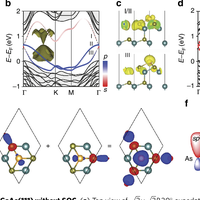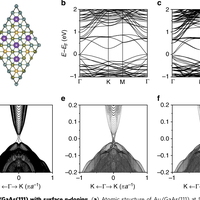Abstract
The quantum spin Hall (QSH) phase is an exotic phenomena in condensed-matter physics. Here we show that a minimal basis of three orbitals (s, p x, p y) is required to produce a QSH phase via nearest-neighbour hopping in a two-dimensional trigonal lattice. Tight-binding model analyses and calculations show that the QSH phase arises from a spin-orbit coupling (SOC)-induced s-p band inversion or p-p bandgap opening at Brillouin zone centre (" point), whose topological phase diagram is mapped out in the parameter space of orbital energy and SOC. Remarkably, based on first-principles calculations, this exact model of QSH phase is shown to be realizable in an experimental system of Au/GaAs(111) surface with an SOC gap of 1/473 meV, facilitating the possible room-temperature measurement. Our results will extend the search for substrate supported QSH materials to new lattice and orbital types.
Figures
Register to see more suggestions
Mendeley helps you to discover research relevant for your work.
Cite
CITATION STYLE
Wang, Z. F., Jin, K. H., & Liu, F. (2016). Quantum spin Hall phase in 2D trigonal lattice. Nature Communications, 7. https://doi.org/10.1038/ncomms12746






